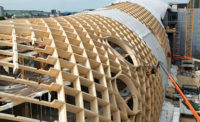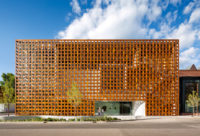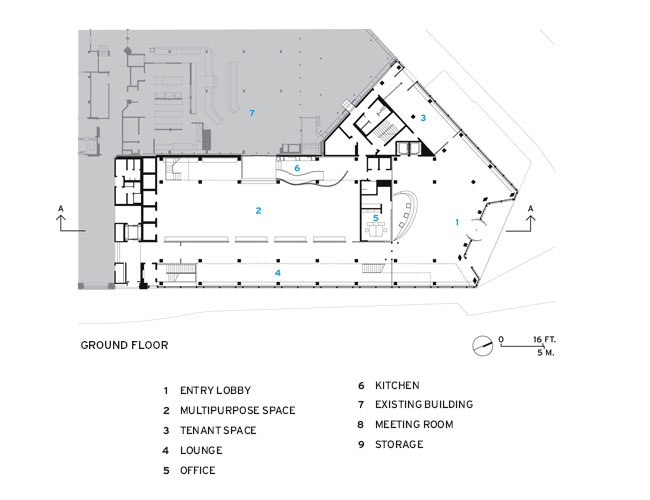Tamedia Headquarters Expansion by Shigeru Ban Architects
Zurich


























Architects & Firms
When asked to design a rather conventional office building for the headquarters complex of the newspaper group Tamedia, in central Zurich, Japanese architect Shigeru Ban decided to support his entire seven-story structure with an exposed timber frame. Workers fitted the laminated Austrian-spruce components together without any metal connectors whatsoever, hammering the rounded ends of the beams into place on the columns with large soft-headed mallets.
Tamedia turned to Ban, this year's Pritzker Prize winner, after giving up the battle to build a 10-story tower by the Swiss firm Bearth & Deplazes. The publishing company abandoned the scheme after it provoked fierce opposition for the shadow it would cast over the leafy banks of the River Sihl, which flows right by the site at the edge of the central business district. “Regulations are quite tough when it comes to the outside form of a building,” says Christoph Zimmer, who oversaw the project as part of his responsibilities as Tamedia's head of corporate communications. “This leads to a pretty uniform cityscape.” The building's distinction would have to come from within.
Outside, Ban's glazed volume continues the modest profile of Tamedia's existing buildings on the river, including a former printing plant next door, to which he added two new floors. But for the inside of the 109,000-square-foot structure, he opted to capitalize on the Swiss tradition in wood building: it was the best way to meet the client's request for a relaxed, domestic atmosphere, according to project architect Kazuhiro Asami. The open office floors combine the untreated timber structure with woven sisal carpeting and a few glass partitions.
In truth, Ban treats the wood more like a high-tech material than the stuff of traditional craft, though there is a resemblance to classical Japanese carpentry. Fabricated in a shop using computer-controlled laser cutters, the structural elements include doubled crossbeams with rounded ends, oval spacer beams that run perpendicular to them, and columns, each a single piece 17 inches square that rises the full height of the building (more than 65 feet). In certain respects these components recall the custom structural elements of Renzo Piano and Richard Rogers's Pompidou Center in Paris, where Ban set up a temporary office while designing the museum's annex in Metz.
The key to the structural design—and its most Pompidou-like detail—is the joint where these three elements come together. The oval spacer beams fit through oval holes in the ends of the crossbeams, fixing them to either side of each column. The oval shape is crucial, because it produces a rigid “grip” joint rather than a weaker pin joint that a circular connector would create, according to Asami. A hidden beech plywood infill element fits into the rounded ends of the beams, addressing stresses that the spruce couldn't meet on its own. Ban developed this novel structural system with the Swiss engineer Hermann Blumer, a renowned specialist in timber design and construction, who also collaborated with Ban on the Metz project. The structure was fabricated and assembled by Blumer-Lehmann, a firm that Blumer was once part of, though he now works independently.
The double row of columns around the building periphery works as a series of vertical trusses to support the 32-foot spans of the floors. The inner row works in compression, while the outer performs in tension (like the tension cables forming the outer layer of the Pompidou in Paris). On the main facade, Ban used the bay between these rows to create a continuous intermediate zone that acts as a thermal buffer. This dynamic multistory space includes runs of stairs and informal lounges, where sections of the facade can be raised on motorized tracks, transforming them into open-air balconies. Here, unencumbered by floor slabs in many areas, the wood structure is displayed to its best advantage.
Due to the continuous columns, the structure was assembled one full bay at a time, working with tolerances of 5 millimeters. The raised floors span 18 feet between the bays and sit on an assembly that includes wood joists, three-layer timber board, and gypsum and cement board (here Ban allowed nails and screws to be used). Sand infill between the joists dampens vibration and provides thermal inertia. Two concrete cores, one in the adjacent existing building, provide lateral bracing. The wood structural elements are over-dimensioned by 2 inches all around, for fire protection. “Charring provides natural protection for the wood components,” explains Zimmer. “In the case of fire it would be stable much longer than a steel structure.” The local fire code allows wood structures of up to six stories (the project team convinced officials that a mezzanine above the lobby was not part of the total floor count).
In contrast to the angled mansard-like facade on the top floor of the new timber structure, Ban spanned his addition next door with a barrel vault, using pretensioned wood beams devised by Blumer to absorb their horizontal thrust. The entry level features a handsome terrazzo floor of widely spaced river stones, along with cardboard tube chairs and tables from Ban's Carta Collection.
Even for a structure largely assembled off-site, the care with which the Tamedia building was built, leaving the exposed wood structure pristine in appearance, is astonishing, a confirmation of the fine craftsmanship available in Switzerland. The presence of the wood, with its massive sections, rounded joinery, and raw, dense materiality, is somehow both prim and voluptuous at the same time. It's an exquisitely contradictory combination of environmental responsibility (wood is renewable and stores carbon dioxide rather than producing it) and sensuous excess, put together with passionate discipline and restraint.
PeopleClient: Tamedia
Architect:
Personnel in architect's firm who should receive special credit: Associate Architect: Jean de Gastines Architectes Local Architect: IttenBrechbühl
Engineers:
m/e/p: 3-Plan Haustechnik
Photographers: Size: 109,000 square feet Completion date: March 2013 |
ProductsTimber structure: Blumer-Lehmann Curtain wall: Aepli Metallbau Interior Glass Partitions: BlessArt River stone Floors: Walo Bertschinger Carpeting: Bolon Lobby furnishings: Wohnbedarf |



















